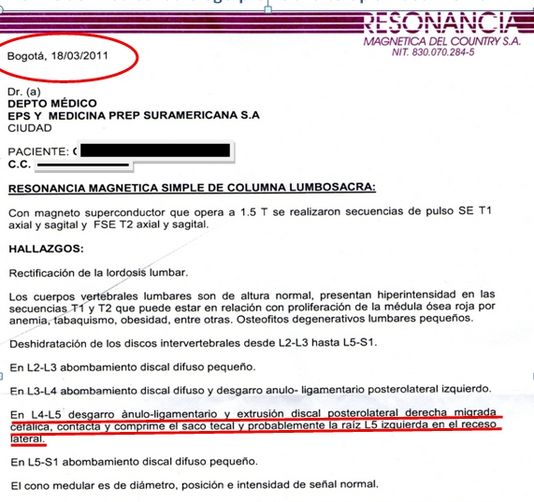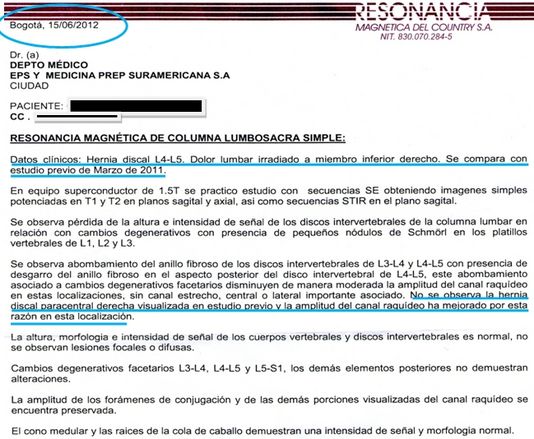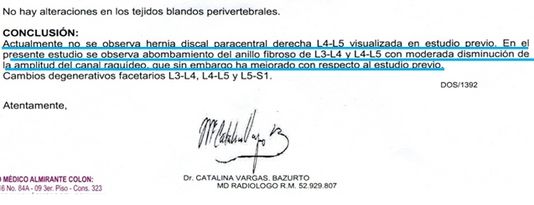Switch language or website
Switch Language
Other countries and websites
AtlasPROfilax® is available around the world in many languages. Please select your region to switch to another website.
SYMPTOM | SINCE HOW LONG | FREQUENCY | PAIN (0/10) |
Trapezium pain | 5 years | 2 episodes per week | 8/10 |
Brachialgia - right | 5 years | 2 episodes per week | 5/10 |
Chronic low back pain that is especially acute in the morning and at the beginning of the walk (with 2 hospitalizations for acute pain) | 5 years | Permanent, all day | from 2 to 10/10 |
MID sciatica that increases in seating | 5 years | Frequent | from 3 to 10/10 |
Cramps in MMIID | 5 years | Frequent | 8/10 |
Irritable colon | Several years | Frequent | - |
Numbness and stiffness in twins in the morning |
| Frequent | - |
Epistaxis | - | Very frequent | - |
SYMPTOM | SYMPTOM IMPROVEMENT | FREQUENCY |
Trapezium pain | 70% improvement | Very sporadic |
Brachialgia - right | 70% improvement | Very sporadic |
Chronic low back pain that is especially acute in the morning and at the beginning of the walk (with 2 hospitalizations for acute pain) | 70% improvement | Almost none. Now he makes efforts, practices sports and activities that were impossible before |
MID sciatica that increases in seating | 100% improvement | It didn't occur again |
Cramps in MMIID | 70% improvement | Very sporadic |
Irritable colon | 80% improvement | Rarely |
Numbness and stiffness in twins in the morning | 65% improvement | Sporadic |
Epistaxis | 100% improvement | Bleeding episodes did not occur again |




A team of doctors followed the evolution of 584 cases of herniated discs for more than two years, between 2007 and 2008 to evaluate the effectiveness of the AtlasPROfilax® Method in its reabsorption and improvement of the symptoms.
| Average age of patients: | Separation by gender: |
|---|---|
| 54 years old | 68% men/ 32% women |
Before therapy, MRIs of the lumbar spine were performed in axial and sagittal sections. The type of pain, especially low back pain or sciatica, its frequency and intensity were noted in the clinical history. The AtlasPROfilax® technique was practiced on all patients and a follow-up control was made every month to know about the evolution of the painful symptoms associated with the hernia. A second control was performed one year later, which included a lumbar radiological examination by MRI in order to be able to establish comparisons with the first MRI showing the disc herniation. In the case of the analysis in the improvement of the associated or referred pain, the scientific method VAS (Visual Analogic Scale) was used to measure the pain.
The results of the herniated disc reabsorption based on the two MRIs compared to one year apart were as follows:
No. of patients | Percentage | ||
Cases with total reabsorption* | 220 | 37,7% | |
Cases with partial resorption | 265 | 45,4% | |
Cases without reabsorption | 99 | 16,9% | |
Total Cases | 584 | 100% | |
*The average time of total reabsorption cases was 14 months. 95% of the patients who presented a total reabsorption of the hernia, had not made other therapies that interfere in the evaluation of the results.
No. of Patients | Percentage | |
The pain improved considerably or disappeared completely | 523 | 89,5% |
The pain did not get better or worse | 13 | 2,2% |
The pain got worse | 48 | 8,3% |
Total Cases | 584 | 100% |
These statistics do not include cases of Lumbar Hernia with Post-Marrow Protrusion, in which patients do not report significant improvement in either the first or second control.
A high percentage of remission or partial or total improvement of the pain referred by patients is observed after AtlasPROfilax® therapy. Interestingly, even in the segment of patients in which the herniated disc showed no change or improvement and remained extruded, a high percentage of these patients reported improvement of symptoms. This is due to the fact that part of the pain attributed to the herniated disk may not be caused by radiculopathy or neuralgia associated with the hernia, but rather by muscle-tendon pain coming from descending chains from the occipital. This explains why people who do not experience improvement in the extrusion of the hernia after the technique are able to report improvements in the symptoms and pain.
A team of doctors followed the evolution of 159 cases of herniated discs for more than two years, between 2007 and 2008 to evaluate the effectiveness of the AtlasPROfilax® Method in its reabsorption and improvement of the symptoms.
| Average age of patients | Separation by gender |
|---|---|
| 52 years old | 59% men/41% women |
Before therapy, MRIs of the lumbar spine were performed in axial and sagittal sections. The type of pain, especially cervicalgias or cervicobrachialgias, its frequency and intensity were noted in the clinical history. The AtlasPROfilax® technique was applied to all patients and a follow-up control was made every month to know about the evolution of the painful symptoms associated with the hernia. A second control was performed one year later, which included an MRI cervical radiological examination in order to establish comparisons with the first MRI showing the disc herniation.
The results of hernia reabsorption based on the two MRIs compared with one year apart were as follows:
No. of Patients | Percentage | ||
Cases with total reabsorption* | 63 | 39,6% | |
Cases with partial resorption | 34 | 21,4% | |
Cases without reabsorption | 62 | 39,0% | |
Total Cases | 159 | 100% | |
Before therapy, MRIs of the lumbar spine were performed in axial and sagittal sections. The type of pain, especially cervicalgias or cervicobrachialgias, its frequency and intensity were noted in the clinical history. The AtlasPROfilax® technique was applied to all patients and a follow-up control was made every month to know about the evolution of the painful symptoms associated with the hernia. A second control was performed one year later, which included an MRI cervical radiological examination in order to establish comparisons with the first MRI showing the disc herniation.
The results of hernia reabsorption based on the two MRIs compared with one year apart were as follows:
*The average time of total resorption cases was 9 months. 93% of the patients who presented total reabsorption of the hernia, had not performed other therapies that interfered with the evaluation of the results.
No. of Patients | Percentage | |
The pain improved considerably or disappeared completely | 123 | 77,5% |
The pain did not get better or worse | 6 | 3,6% |
The pain got worse | 30 | 18,9% |
Total Cases | 159 | 100% |
These statistics do not include cases of Cervical Hernia with Post Marrow Protrusion, in which patients do not report significant improvement in either the first or second control.
A high percentage of remission or partial or total improvement of the pain referred by patients is observed after AtlasPROfilax® therapy. Interestingly, even in the segment of patients in which the herniated disc showed no change or improvement and remained extruded, a high percentage of these patients reported improvement of symptoms. This is due to the fact that part of the pain attributed to the herniated disk may not be caused by radiculopathy or neuralgia associated with the hernia, but rather by muscle-tendon pain coming from descending chains from the occipital. This explains why people who do not experience improvement in the extrusion of the hernia after the technique are able to report improvements in the symptoms and pain.